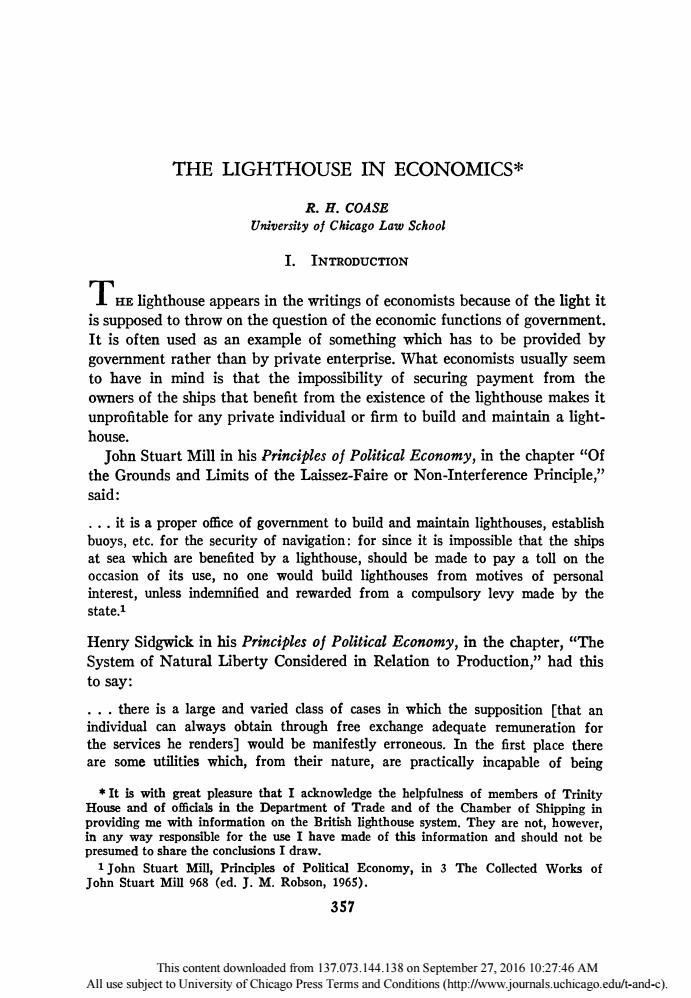
THE LIGHTHOUSE IN ECONOMICS* rhCOASE University of Chicago Law School I.INTRODUCTION lighthouse appears in the writings of economists because of the light it is suppo ed to throw on the question of the economic f It is often used as an example of something which has to be provided by government rather than by private enterprise.What economists usually seem to have in mind is that the impossibility of securing payment from the owners of the ships that benefit from the existence of the lighthouse makes it unprofitable for any private individual or firm to build and maintain a light- house John Stuart Mill in his Principles of Political Economy,in the chapter"Of the Grounds and Limits of the Laissez-Faire or Non-Interference Principle," said: it is a proper office of government to build and maintain lighthouse s establish buo the ce it is imp sible that the ships by a lighth d be C) sion of its e to tol pa a I on the ould bu nified ouse fron mo ves o Henry Sidgwick in his Principles of Political Economy,in the chapter The System of Natural Liberty Considered in Relation to Production,"had this to say: there is a large and varied class of cases in which the supposition [that an individual can alw ays obtain through free exchange adequate tion for the services he renders]would be manifestly erron eous.In the first place the aresom,from their nature,are practically incapable of being +It is with great pleasure that I acknowledge the helpfulness of members of Trinity in the ade and of the Chamber of Shipping in in any way presumed to share the conclusions I draw. 357 Terms and Conditions(http://www.journals.uchicago.edu/t-and-c)
This content downloaded from 137.073.144.138 on September 27, 2016 10:27:46 AM All use subject to University of Chicago Press Terms and Conditions (http://www.journals.uchicago.edu/t-and-c)
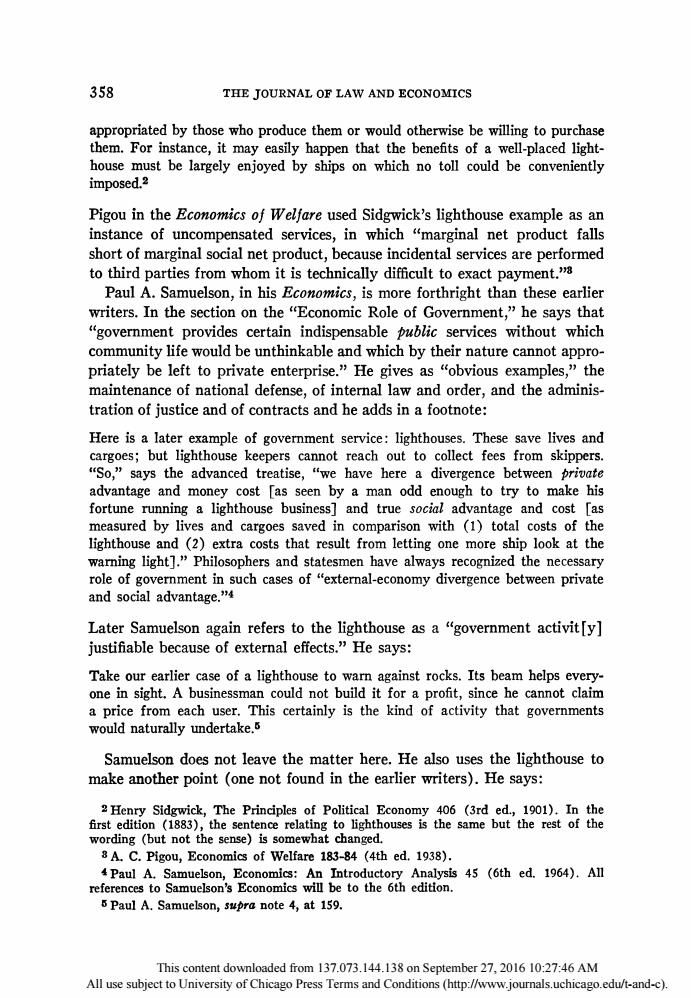
358 THE JOURNAL OF LAW AND ECONOMICS appropriated by those who produce them or would otherwise be willing to purchase them.For instance,it may easily happen that the benefits of a well-placed light- house must be largely enjoyed by ships on which no toll could be conveniently imposed.2 Pigou in the Economics of Welfare used Sidgwick's lighthouse example as an instance of uncompensated services,in which "marginal net product falls short of marginal social net pro to third partiesfromwhom it is technicallyiffculttoxact payment Paul A.Samuelson,in his Economics,is more forthright than these earlier writers.In the section on the"Economic Role of Government,"he says that "government provides certain indispensable ublic services without which community life would be unthinkable and which by their nature cannot appro- priately be left to private enterprise."He gives as "obvious examples,"the maintenance of national defense,of internal law a nd order,and the adminis tration of justice and of contracts and he adds in a footnote: Here is a later example of government service:lighthouses.These save lives and ers cannot reach out to collect fees from skipp we have here a dive rgence bety een advantae 「ass gh to try to make his fort lighth and true and ost ra ured by cargo ve total t result fr ng one mo hip look at the ng light].”」 costs tha sophers and the nece and social advantage. Later Samuelson again refers to the lighthouse as agovernment activit[y] justifiable because of external effects."He says: Take our earlier case of a lighthouse to warn against rocks.Its beam helps every- one in sight.A businessman could not build it for a profit,since he cannot claim a price from each user.This certainly is the kind of activity that governments would naturally undertake.s Samuelson does not leave the matter here.He also uses the lighthouse to make another point (one not found in the earlier writers).He says: ) The Principles of Politic in u he sense)is somewhat changed. hthoeme buttht the 8A.C.Pigou,Economics of Welfare 183-84 (4th ed.1938). 4 Paul A. omics:An Introductory Analysis 45 (6th ed.1964).All references to Samuelson's Economics will be to the 6th edition. 5 Paul A.Samuelson,supra note 4,at 159. This wnloaded from 137073 144 138 on Se ember27201610-27-46AM All use subject to University of Chicago Press Terms and Conditions (http://www.journals.uchicago.edu/tand-c)
This content downloaded from 137.073.144.138 on September 27, 2016 10:27:46 AM All use subject to University of Chicago Press Terms and Conditions (http://www.journals.uchicago.edu/t-and-c)
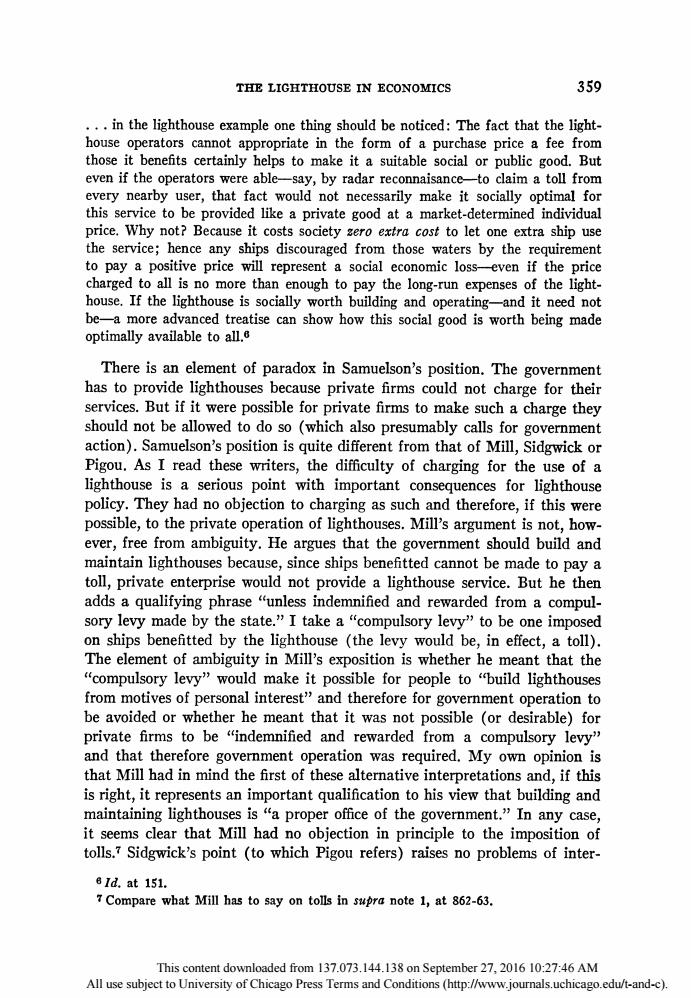
THE LIGHTHOUSE IN ECONOMICS 359 inthe lighthouse thing should be noticed:The fact that the light e operator cannot appropriate in the form of a purchase price a fee from those it benefits certainly helps to make it a suitable social or public good.But even if the operators were able-say,by radar reconnaisance-to claim a toll from every nearby user,that fact would not necessarily make it socially optimal for this service to be provided like a private good at a market-determined individual price.Why not?Because it costs society zero extra cost to let one extra ship use the service;hence any ships discouraged from those waters by the requirement to pay a positive price will represent a social economic loss even if the price charged to all is no more than enough to pay the long-run orth building expenses of the light- house.If the lighthouse is sociallv and c and it need not be -a more advanced treatise can show ho thi cial go od is optimally available to all.e orth being ma There is an element of paradox in Samuelson's position.The government has to provide lighthouses ecause private firms could not charge for their services.But if it were possible for private firms to make such a charge they should not be allowed to do so (which also presumably calls for government action).Samuelson's position is quite different from that of Mill,Sidgwickor Pigou.As I read these writers,the difficulty of charging for the use of a lighthouse is a serious point with important consequences for lighthouse policy.They had no objection to charging as such and therefore,if this were possible,to the private operation of lighthouses.Mill's argum ent is not,how ever,free from ambiguity.He argues that the government should build and maintain lighthouses because,since ships benefitted cannot be made to pay a toll,private enterprise would not provide a lighthouse service.But he then adds a qua rase nle ndemnified and rewarded from a compul sory levy made by the state."I take a"compulsory levy"to be one imposed on ships benefitted by the lighthouse (the levy would be,in effect,a toll). The element of ambiguity in Mill's exposition is whether he meant that the ory levy wo uld make it possible for people tould lighthouses from motives of personal interest"and therefore for government operation to be avoided or whether he meant that it was not possible (or desirable)for private firms to be "indemnified and rewarded lev and th t therefore government operation was required.My own opinion is that Mill had in mind the first of these alternative interpretations and,if this is right,it represents an important qualification to his view that building and maintaining lightho proper office of the any case it seems clear that Mill had no objection in principle to the imposition of tolls.7 Sidgwick's point (to which Pigou refers)raises no problems of inter- 81d.at151 7Compare what Mill has to say on tolls in supra note 1,at862-63. Alluse subject toniversi of chi on Seperber 0110AM edu/t-and-c)
This content downloaded from 137.073.144.138 on September 27, 2016 10:27:46 AM All use subject to University of Chicago Press Terms and Conditions (http://www.journals.uchicago.edu/t-and-c)
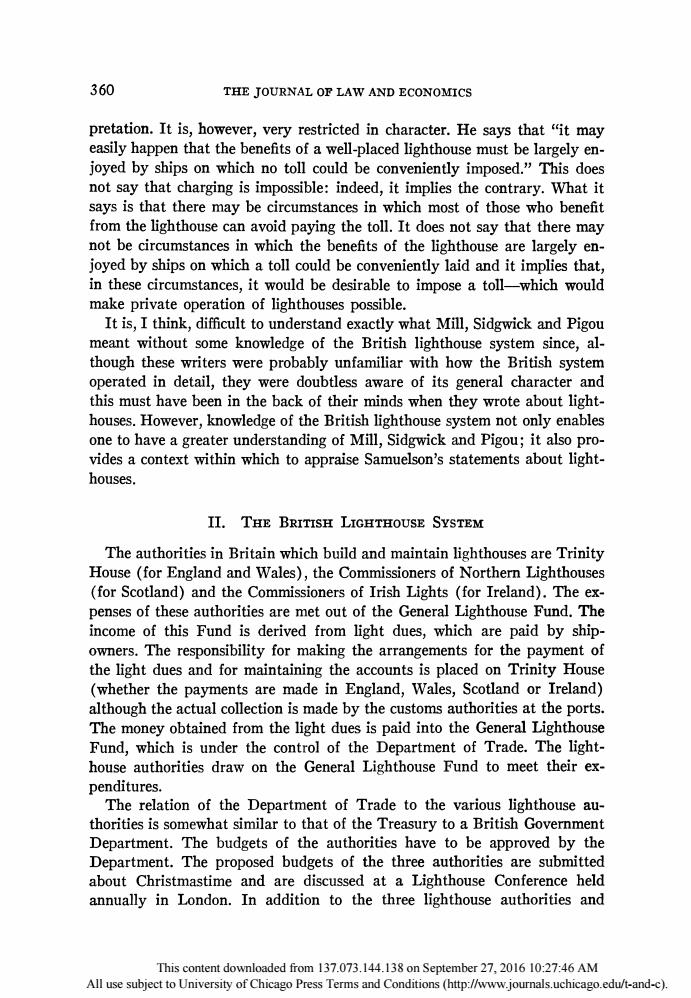
360 THE JOURNAL OF LAW AND ECONOMICS pretation.It is,however,very restricted in character.He says that "it may easily happen that the benefits of a well-placed lighthouse must be largely en joyed by shins on which no toll c ould be imposed,.”This doe not say that charging is impossible:indeed,it implies the contrary.What it says is that there may be circumstances in which most of those who benefit from the lighthouse can avoid paying the toll.It does not say that there may not be circumstances in which the benefits of the lighthouse are largely en joyed by ships on which a toll could be conveniently laid and it implies that, in these circumstances,it would be desirable to impose a toll-which would make private operation of lighthou possible It is,I think,difficult to understand exactly what Mill,Sidgwick and Pigou meant without some knowledge of the British lighthouse system since,al- though these writers were probably unfamiliar with how the British system p erated in detail,they were doubtless aware of its general character and this must have been in the back of their minds when they wrote about light- houses.However,knowledge of the British lighthouse system not only enables one to have a gre eater understanding of Mill,Sidgwick and Pigou;it also pro vides a context within which to appraise Samuelson's statements about light. houses. IL THE BRITISH LIGHTHOUSE SVSTEM The authorities in Britain which build and maintain lighthouses are Trinity House (for England and Wales),the Commissioners of Northern Lighthouses (for scotland)and the commissioners of irish lights (for ireland).The ex- penses of thes e authorities are met out of the General Lightho ouse Fund.The income of this Fund is derived from light dues,which are paid by ship- owners.The responsibility for making the arrangements for the payment of the light dues and for maintaining the accounts is placed on Trinity House (whether the payments are made in England,Wales,Scotland or Ireland) although the actual collection is made by the customs authorities at the ports. The money obtained from the light dues is paid into the General Lighthouse Fund,which is under the ntrol of the D partmen of Trade.The light- house authorities draw on the General Lighthouse Fund to meet their ex- penditures. The relation of the Department of Trade to the various lighthouse au- thorities is somewhat similar to that o of the Tre sury to a British Gov Department.The budgets of the authorities have to be approved by the Department.The proposed budgets of the three authorities are submitted about Christmastime and are discussed at a Lighthouse Conference held annually in London.In addition to the three lighthouse authorities and This wnloaded from 137073 144 138 on Se ember27201610-27-46A All use subject to University of Chicago Press Terms and Conditions(http://www.journals.uchicago.edu/t-and-c)
This content downloaded from 137.073.144.138 on September 27, 2016 10:27:46 AM All use subject to University of Chicago Press Terms and Conditions (http://www.journals.uchicago.edu/t-and-c)

THE LIGHTHOUSE IN ECONOMICS 361 the Department,there are also present at the conference members of the Lights Advis, Committee,a c ommittee of the Chamber of Shipping (a trade association)representing shipowners,underwriters and shippers.The Lights Advisory Committee,although without statutory authority,plays an important part in the review pre cedure and the as it expresses taken into account both by the lighthouse authorities in drawing up their budgets and by the Department in deciding on whether to approve the budgets.The light dues are set by the Department at a level which will yield,over a period of rs,an amount of money sufficient to meet the likely expenditures.But in deciding on the program of works and changes in existing arrangements the participants in the conference,and particularly the mem- bers of the Lights Advisory Committee,have regard to the effect which new works or changes in existing arrangements would have on the level of light dues The basis on which light dues are levied was set out in the second Schedule to the Mercha nt ing (Mercantile Marine Fund)Act of 189.Modifica- tions to the level of the dues and in certain other respects have been made since then by Order in Council but the present method of charging is essen. tially that established in 1898.The dues are so much per net ton e for all vesels arrivin at or departing from.ports case of "Home Trade"ships,there is no further liability for light dues after 'sduo-u opue 01 is no further liability afte 6o) ages. The light dues different for these two categories of ship and are such that,for a s ship of given size,10 voyages for a"Home Trade"ship yield approximately the same sum as 6 voyages for a "Foreign-going"ship.Some categories of ship pay at a lower rate per net ton:sailir gvessels of more thar 00 tons and cruise ships.Tugs and pleasure yachts make an annual payment rather than a payment per voyage.In addi- tion,some ships are exempt from light dues:ships belonging to the British or Foreign Governments (unless ca ying carg r passe for remunera tion),fish ing vessels,hoppers an dredges,sailing vessels (except pleasure yachts)of less than 100 tons,all ships (including pleasure yachts)of less than 20 tons,vessels (other than tugs or pleasure yachts)in ballast,or put- ting in for bunker fuel or stores be ase of the haz rds of the sea.Al these statements are subject to qualification.But they make clear the general nature of the scheme. The present position is that the expenses of the British lighthouse service are met out of the General Lighthouse Fund,the income of which comes from light dues.In addition to expenditures on lighthouses in Great Britain 861&62Vic.c44.sch.2 e地9gnme28063om570731458 on sepier虹.2016102726N cago Conditions(http://www.journals.uchicago.edu/t-and-c)
This content downloaded from 137.073.144.138 on September 27, 2016 10:27:46 AM All use subject to University of Chicago Press Terms and Conditions (http://www.journals.uchicago.edu/t-and-c)

362 THE IOURNAL OF LAW AND ECONOMICS and Ireland,the Fund is also used to pay for the maintenance of some colonial lighthouses and to meet the cost of marking and clearing wrecks (to the extent that these are not reimbursed by a salvaging firm),although these very small proportion of total expenditures. There are also expenditures on lighthouses which are not met out of the Fund.The expenses of building and maintaining"local lights,"those which are only of benefit to ships using particular ports,are not paid for out of the Fund,which is restricted to the finance of lighthouses which are useful for "general navi. gation."The expenditures for "local lights"are normally made by harbour authorities,and are recovered out of port dues. III.THE EVOLUTION OF THE BRITISH LIGHTHOUSE SYSTEM Mill,writing in 1848,and Sidgwick,in 1883,to the extent that they had in mind the actual British lighthouse system,would obviously be thinking of earlier arrangements.To understand Mill and Sidgwick,we need to know something of the lighthouse system in the 19th century and of the way in which it had ev olved.But a stud of the history of the British lighthou system is not only useful because it helps us to understand Mill and Sidgwick but also because it serves to enlarge our vision of the range of alternative insti- tutional arrangements available for operating a lighthouse service.In dis- cussing the history of the British lighthouse service,I will confine myself to England and Wales,which is,presumably,the part of the system with which Mill and Sidgwick would have been most familiar. The cipal lighthouse authority in England and Wales is Trinity House.It is also the principal pilotage authority for the United Kingdom. It maintains Homes and administers charitable trusts for mariners,their wives,widows,and orphans.It has also many miscellaneous responsibilities, example the inspect and regulation of "ocal lights"and the provision of Nautical Assessors or Trinity Masters at the hearing of marine cases in the Law Courts.It is represented on a number of harbour boards,including the Port of London Authority,and members of Trinity House serve on many committees ding government c mittees)dealing with maritime e matter Trinity House is an ancient institution.It seems to have evolved out of a medieval seamen's guild.A petition asking for incorporation was presented to Henry VIII in 1513 and letters patent were granted in 1514.The charter gave Trinity House the right to regulate pilotage,and this,together with its rinoue of Deptord 1913-1060. ns Markes and Siges for the Sea and ch.&An Vncertaine Light. This wnloaded from 137073 144 138 on Ser tember27201610-27-46A All use subject to University of Chicago Press Terms and Conditions(http://www.jo urnals uchicago edu/t-and-c)
This content downloaded from 137.073.144.138 on September 27, 2016 10:27:46 AM All use subject to University of Chicago Press Terms and Conditions (http://www.journals.uchicago.edu/t-and-c)
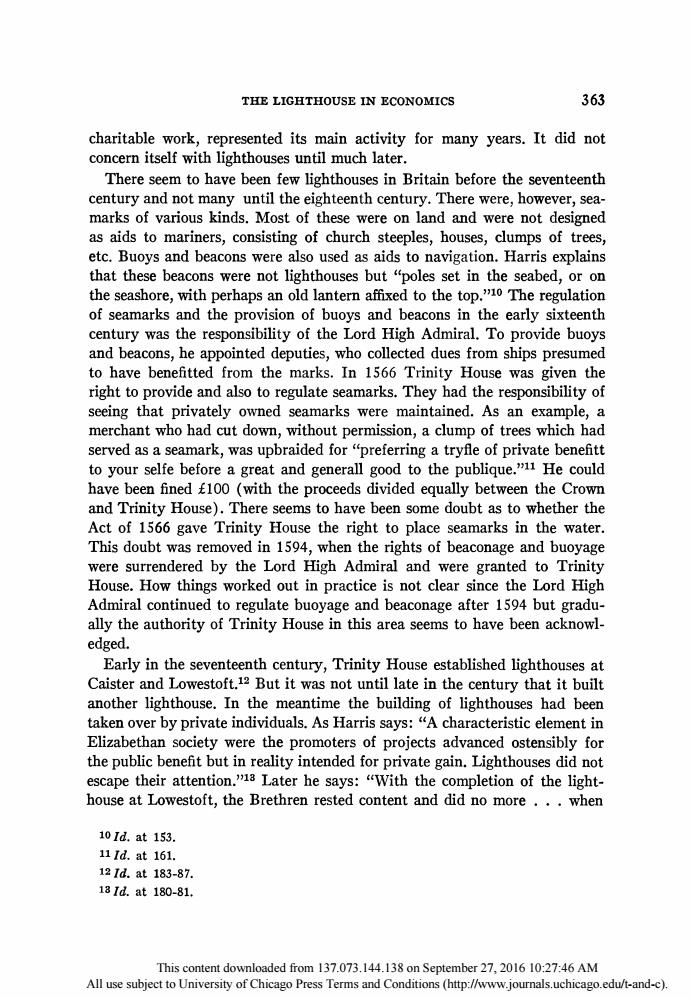
THE LIGHTHOUSE IN ECONOMICS 363 charitable work,represented its main activity for many years.It did not con cern itself with lighthouses until much late There seem to have been few lighthouses in britain before the seventeenth century and not many until the eighteenth century.There were,however,sea- marks of various kinds.Most of the ese were on and and wer not designed as aids to mariners,consisting of church steeples,houses,clumps of trees, etc.Buoys and beacons were also used as aids to navigation.Harris explains that these beacons were not lighthouses but "poles set in the seabed,or on the seashore,with perhaps an old lantern affixed to the top 1 The regulation of seamarks and the provision of buoys and beacons in the early sixteenth century was the responsibility of the Lord High Admiral.To provide buoys and beacons,he ap pointed eputies, who collected dues from ships presum to have benefitted from the marks.In 1566 Trinity House was given the right to provide and also to regulate seamarks.They had the responsibility of seeing that privately owned seamarks were maintained.As an example,a merchant who had cut dowr ithout permission,a clum of trees which had served as a seamark,was upbraided for "preferring a tryfle of private benefitt to your selfe before a great and generall good to the publique."11 He could have been fined 100(with the proceeds divided equally between the Crown and Trinity House) There seems to have been so ome doubt as to whether the Act of 1566 gave Trinity House the right to place seamarks in the water. This doubt was removed in 1594,when the rights of beaconage and buoyage were surrendered by the Lord High Admiral and were gran ated to Trinit House.How things worked out in practice is not clear since the Lord High Admiral continued to regulate buoyage and beaconage after 1594 but gradu- ally the authority of Trinity House in this area seems to have been acknowl- edged. Early in the seventeenth century,Trinity House established lighthouses at Caister and LowestoftBut it was not until late n the cetury that itbuilt another lighthouse.In the m ntime the building had been taken over by private individuals.As Harris says:"A characteristic element in Elizabethan society were the promoters of projects advanced ostensibly for the public benefit but in reality intended for private gain.Lighthouses did not scape he says:With the ofthelight- house at Lowestoft,the Brethren rested content and did no more.when 101d.at153. 111dat161 121d.at183-87. 131d.at180-81 All subject tnvri of chded om 137 on Seper 011M Terms and Conditions (http://www.Journals.uchicago.e edu/t-and-c)
This content downloaded from 137.073.144.138 on September 27, 2016 10:27:46 AM All use subject to University of Chicago Press Terms and Conditions (http://www.journals.uchicago.edu/t-and-c)
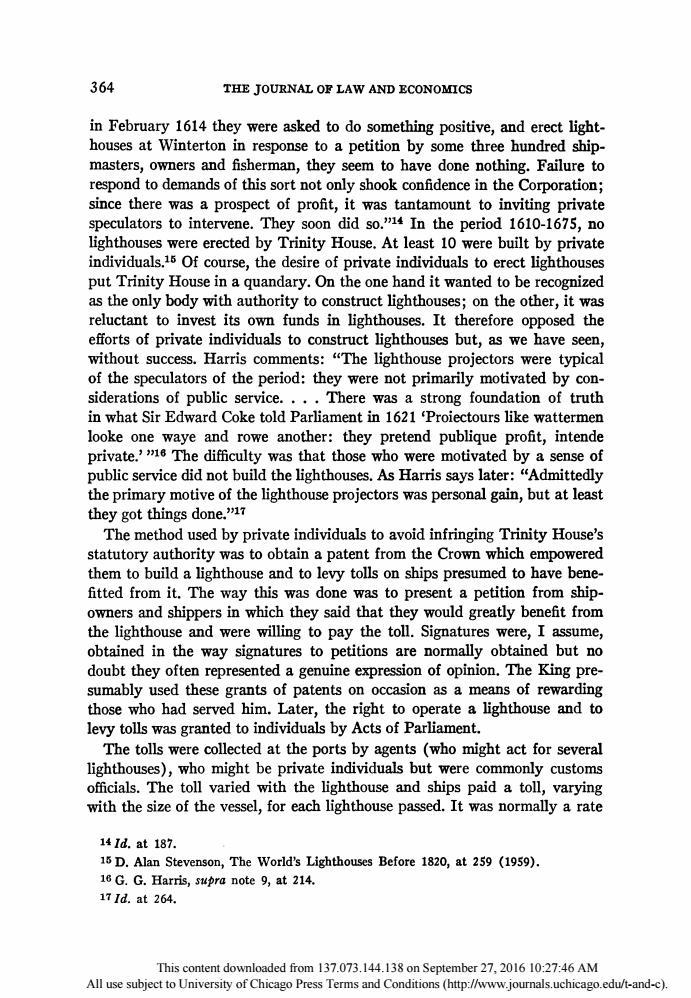
364 THE JOURNAL OF LAW AND ECONOMICS in February y 1614 they were asked to do something positive,and erect light- houses at Winterton in response to a petition by some three hundred ship- masters,owners and fisherman,they seem to have done nothing.Failure to respond to demands of this sort not only shook confidence in the Corporation since there was a prospect of profit,it was tantamount to inviting private speculators to intervene.They soon did so."14 In the period 1610-1675,no lighthouses were erected by Trinity House.At least 10 were built by private individuals.6 Of course,the desire of private individuals to erect lightho put Trinity House in a quandary.On the one hand it wanted to be recognized as the only body with authority to construct lighthouses;on the other,it was reluctant to invest its own funds in lighthouses.It therefore opposed the efforts of private individuas to construct lighthouses but,ase have see without success.Harris comments:"The lighthouse projectors were typical of the speculators of the period:they were not primarily motivated by con- ns of public erv There wa foundation of truth in what Sir Edward Coke told Parliament in 1621Proiectours like wattermen looke one waye and rowe another:they pretend publique profit,intende private.'"1e The difficulty was that those who were motivated by a sense of public service did not build the lighthouses. As Harris says later: “Admittedly the primary motive of the lighthouse projectors was personal gain,but at least they got things done."17 The method used by private individuals to avoid infringing Trinity House's statutory authority was to obtain a patent from the Crown which empowered them to build a lighthouse and to levy tolls on ships presumed to have bene- fitted from it.The way this was done was to present a petition from ship- owners and shippers in which they said that they would greatly benefit from the lighthouse and were willing to pay the toll.Signatures were,I assume, obtained in the way signatures to petitions are normally obtained but no doubt they often represented a gen uine expression of opinion.The King sumably used these grants of patents on occasion as a means of rewarding those who had served him.Later,the right to operate a lighthouse and to levy tolls was granted to individuals by Acts of Parliament. The tolls were collected at the ports by agents (who might act for several lighthouses),who might be private individuals but were commonly customs officials.The toll varied with the lighthouse and ships paid a toll,varying with the size of the vessel,for each lighthouse passed.It was normally a rate 141d.at187. 15 D.Alan Stevenson,The World's Lighthouses Before 1820,at 259 (1959). 16 G.G.Harris,supra note 9,at 214. 17Id.at264. This ontent de wnloaded from 137073 144 138 on Se ember27201610-27-46AM All use subject to University of Chicago Press Terms and Conditions(http://ww.jo urnals uchicago edu/t-and-c)
This content downloaded from 137.073.144.138 on September 27, 2016 10:27:46 AM All use subject to University of Chicago Press Terms and Conditions (http://www.journals.uchicago.edu/t-and-c)

THE LIGHTHOUSE IN ECONOMICS 365 per ton (say 4d or 1d)for each voyage.Later,books were published setting out the lighthouses passed on different voyages and the charges that would be made In the meantime,Trinity House came to adopt a policy which maintained its rights while preserving its money (and even increasing it).Trinity House would apply for a patent to operate a lighthouse and would then grant a leas for a rental,to a private individual who would then build the lighthouse with his own money.The advantage to a private individual of such a procedure would be that he would secure the co-operation rather than the opposition of Trinity House. An example of this is afforded by the building.and rebuilding.of what is probably the most celebrated British lighthouse the Eddystone,on a reef of rocks some 14 miles offshore from Plymouth.D.Alan Stevenson comments: "The construction of 4 lighthouses in succession on the Eddystone Rocks by 1759 provides the most dramatic chapter in lighthouse history:in striving to withstand the forc of the waves thei ed ent ise,ingenuity and courage of a high order.' 3 In 1665,a petition for a lighthouse on the Eddystone Rocks was received by the British Admiralty.Trinity House com- mented that,though desirable,it"could hardly be accomplished."1 As Samuel Smiles,that chronicler of private enterprise,says,".it was long before any private adventurer was found ready to undertake so daring an enterprise as the erection of a lighthouse on the Eddystone,where only a little crest of rock was visible at high water,scar 20 pable of affording foothold for a struc ture of the very narrowest basis. In 1692,a proposal was put forward by Walter Whitfield,and Trinity House made an agreement with him under which he was to build the lighthouse and Trinity House was to share equally in whatever profits were made.Whitfield didnot,hov ever undertake the His rights were transferred to Henry Winstanley,who,after negotiating with Trinity House,made an agreement in 1696 under which he was to receive the profits for the first five years,after which Trinity House was to share equally in whatever profits were ea red or years. Winstanley built one to and then replaced it with another,the lighthouse being completed in 1699.How- ever,in a great storm in 1703,the lighthouse was swept away,and Winstanley, the lighthousekeepers,and some of his workmen,lost their lives.The total cost up to this time had been 8,000 (all of which had been borne by Win stanley)and the receipts had been 4,000.The government gave Winstanley's widow E200 and a pension of f100 per annum.If the construction of light- 18D.Alan Stevenson,supra note 15,at 113 22 Samuel Smiles,Lives of the Engineers 16(1861). Alluse subject Universi of Chiao 1 on Seper0AM ss Terms and edu/t-and-c)
This content downloaded from 137.073.144.138 on September 27, 2016 10:27:46 AM All use subject to University of Chicago Press Terms and Conditions (http://www.journals.uchicago.edu/t-and-c)
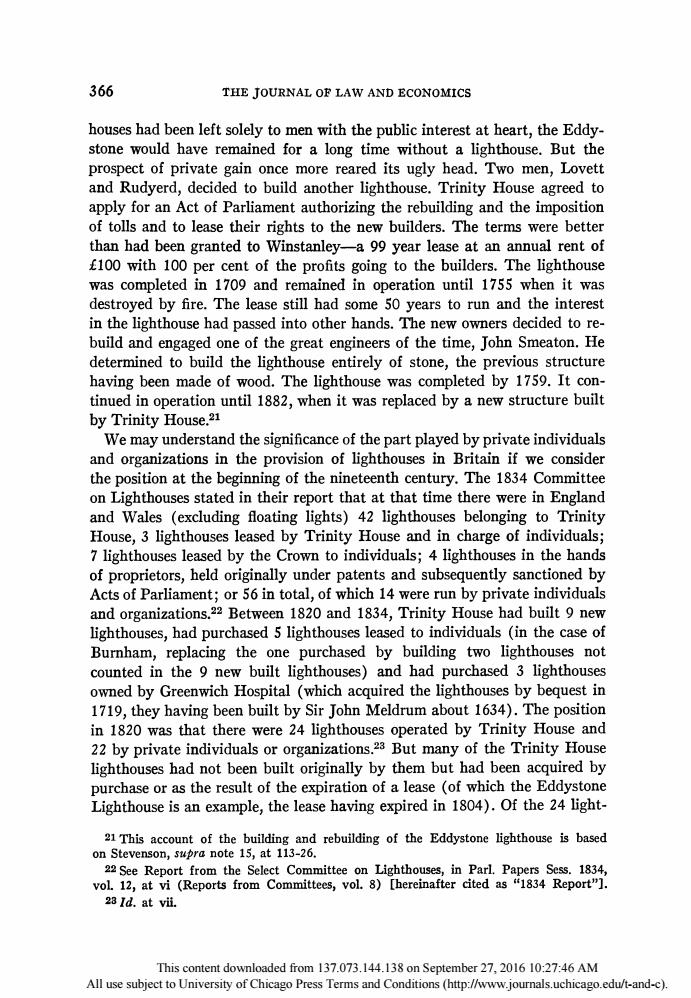
366 THE JOURNAL OF LAW AND ECONOMICS houses had been left solely to men with the public interest at heart,the Eddy stone would have remained for a long time without a lighthouse.But the pect of private more reared its ugly head.Two men,Lovet and Rudyerd,decided to build another lighthouse.Trinity House agreed to apply for an Act of Parliament authorizing the rebuilding and the imposition of tolls and to lease their rights to the new builders.The terms were better than had been granted to Winstanley-a 99 year lease at an annual I rent of f100 with 100 per cent of the profits going to the builders.The lighthouse was completed in 1709 and remained in operation until 1755 when it was destroyed by fire.The lease still had s years to run and the interest in the lighthouse had passed into other hands.The new owners decided to re- build and engaged one of the great engineers of the time,John Smeaton.He determined to build the lighthouse entirely of stone,the previous structure ving h een made of wood.The lighthouse e was s completed by 1759.It con tinued in operation until 1882,when it was replaced by a new structure built by Trinity House.21 We may understand the significance of the p part played by private individuals and organizations in the provision of lighthouses in Britain if we consider the position at the beginning of the nineteenth century.The 1834 Committee on Lighthouses stated in their report that at that time there were in England and Wales (excluding floatir lights)42 lighthouses belonging to Trinity House,3 lighthouses leased by Trinity House and in charge of individuals; 7 lighthouses leased by the Crown to individuals;4 lighthouses in the hands of proprietors.held originally under patents and subsequently sanctioned by Acts of Parli O r 56 in total,of which 14 run by private individual and organizations Between 1820 and 1834,Trinity House had lighthouses,had purchased 5 lighthouses leased to individuals (in the case of Burnham. replacing the one purchased by building two lighthouses not counted in the 9 new built lighth uses) and had rch sed 3 lightho owned by Greenwich Hospital(which acquired the lighthouses by bequest in 1719,they having been built by Sir John Meldrum about 1634).The position in1820 that th were 24 ligh operated by Trinity House and 22 by private individuals or organizations.2 But many of the Trinity Hous lighthouses had not been built originally by them but had been acquired by purchase or as the result of the expiration of a lease(of which the Eddystone Lighthouse is an example,the lease having expired in 1804).Of the 24 light- 21This account of the building and rebuilding of the Eddystone lighthouse is based on Stevenson,supra note 15,at 113-26. This wnloaded from 137073 144 138 on Se ember27201610-27-46A All use subject to University of Chicago Press Terms and Conditions(http://www.jo urnals uchicago edu/t-and-c)
This content downloaded from 137.073.144.138 on September 27, 2016 10:27:46 AM All use subject to University of Chicago Press Terms and Conditions (http://www.journals.uchicago.edu/t-and-c)